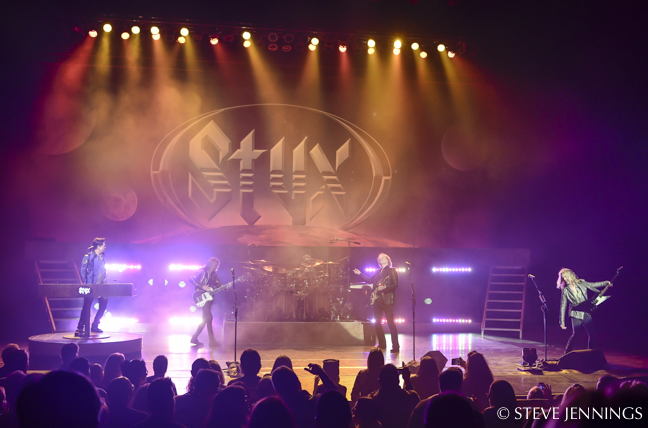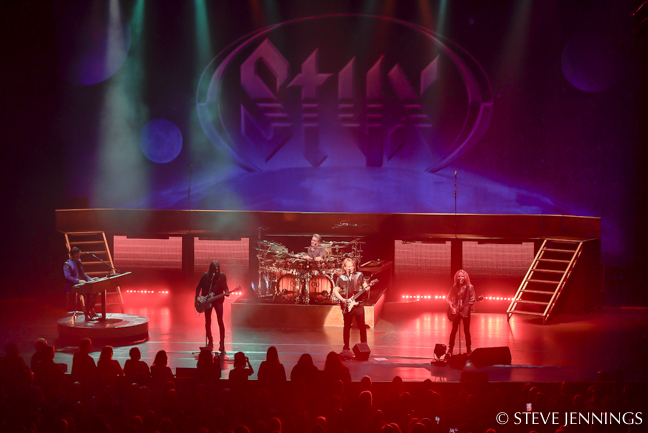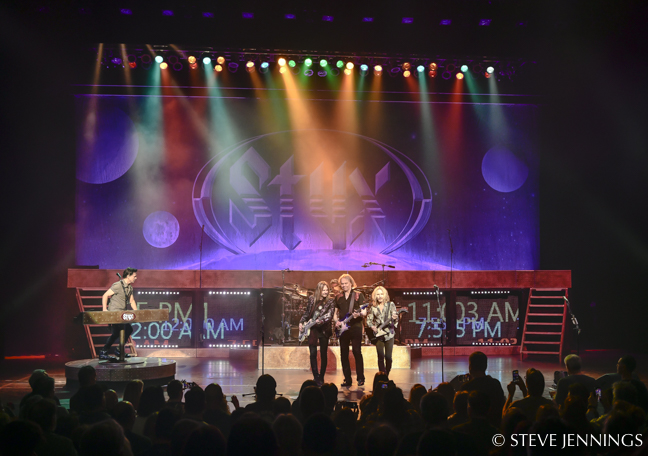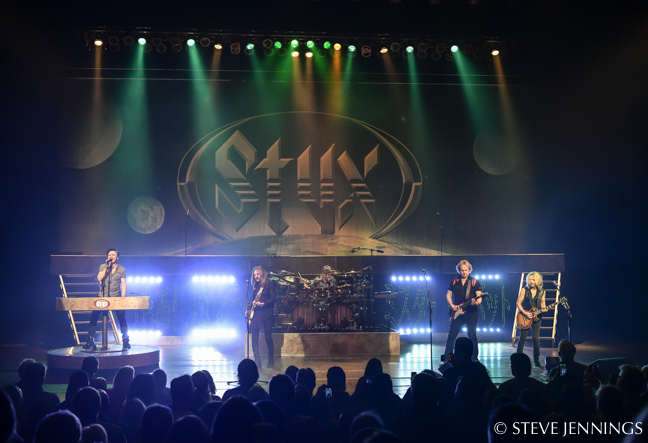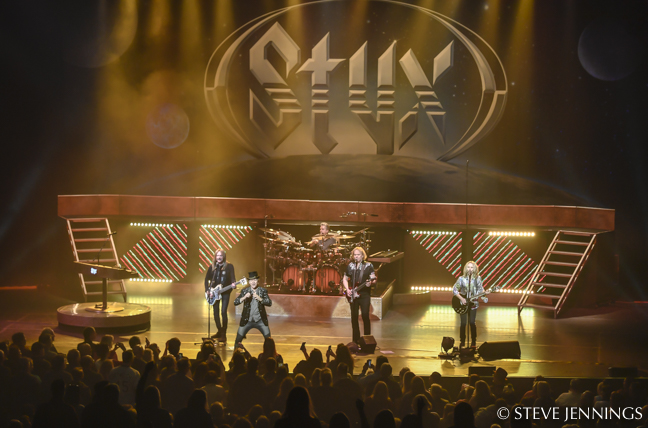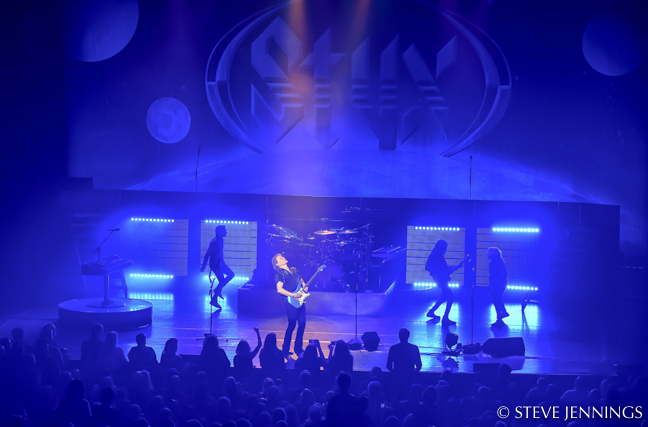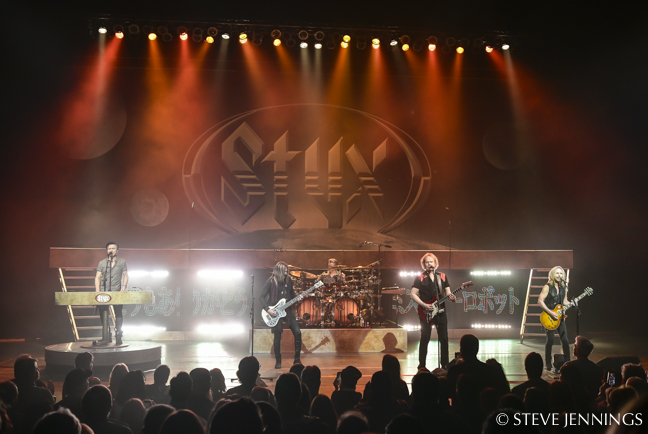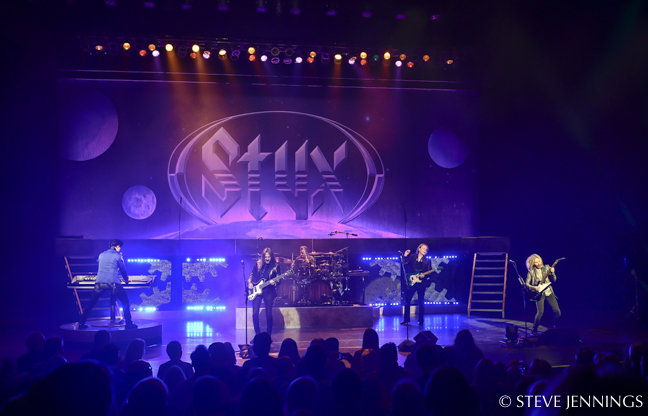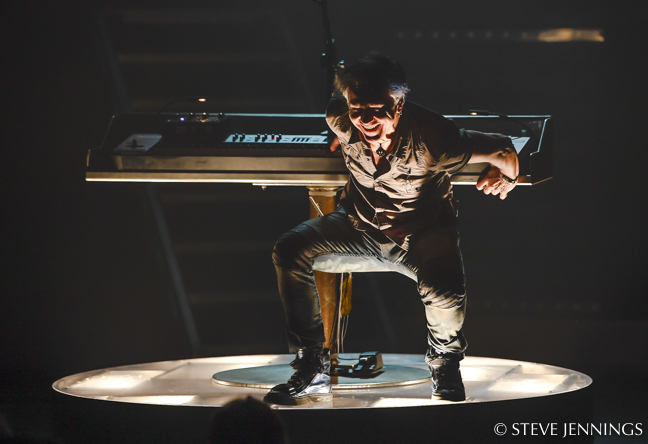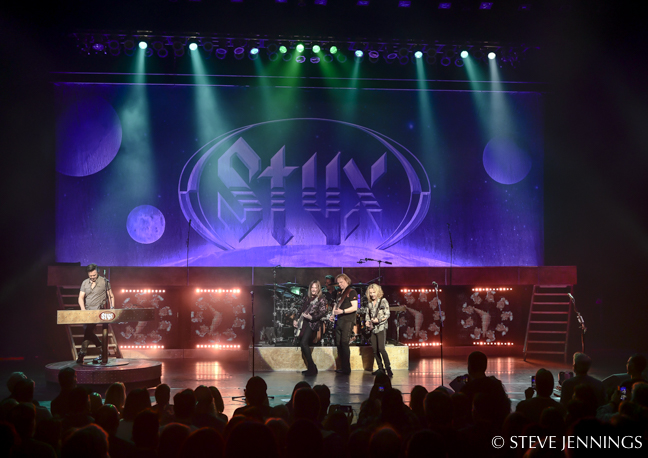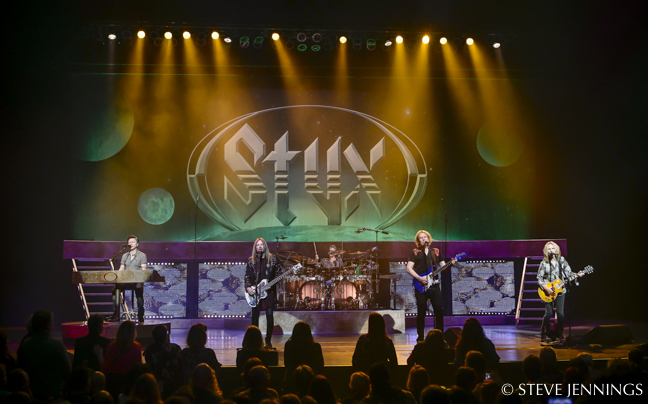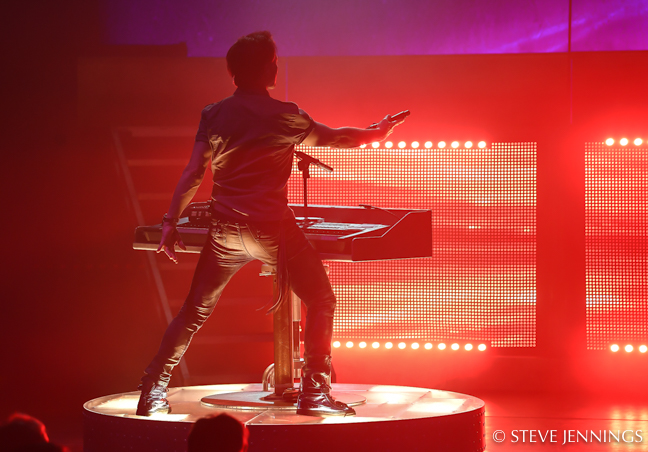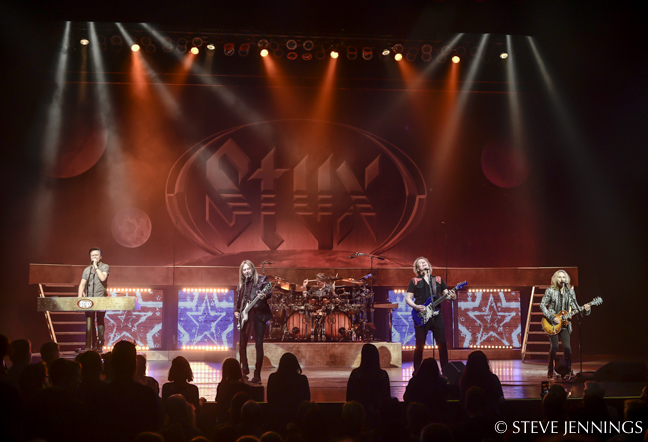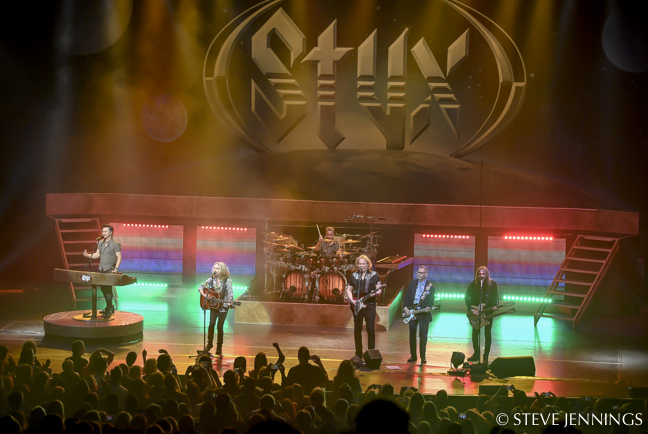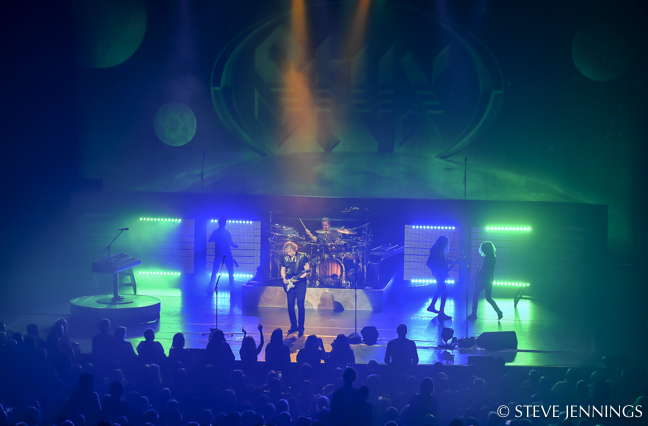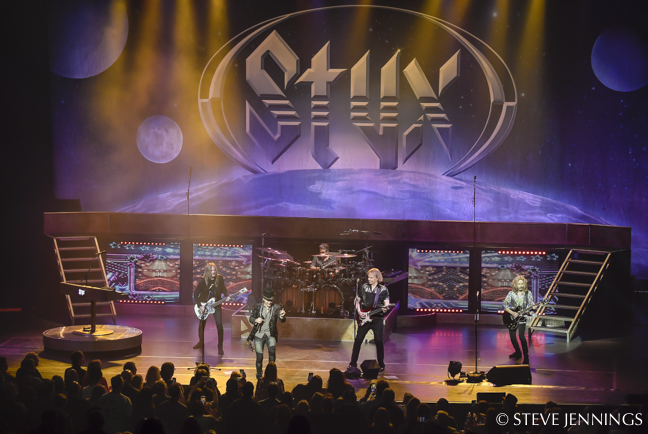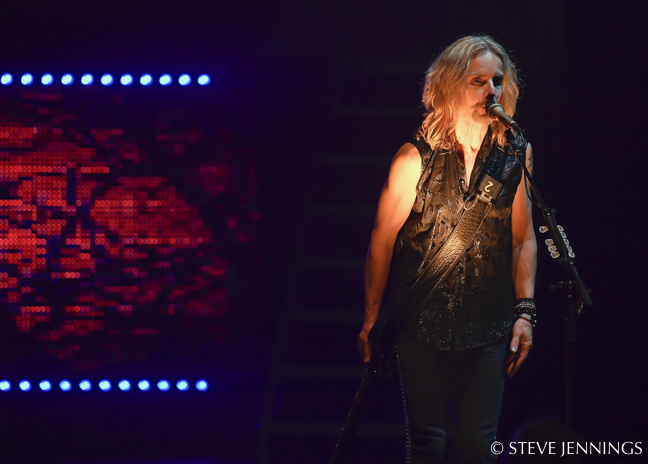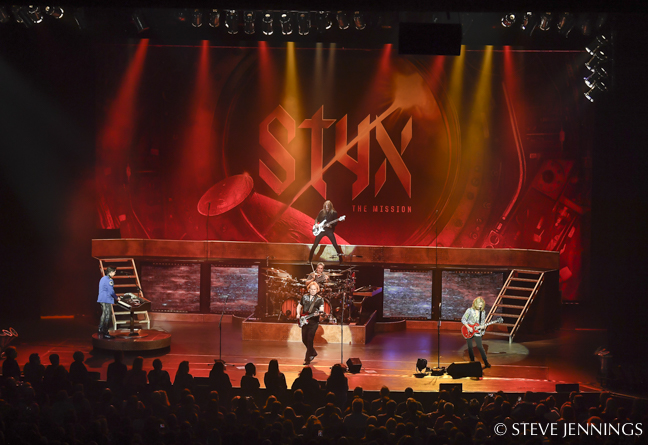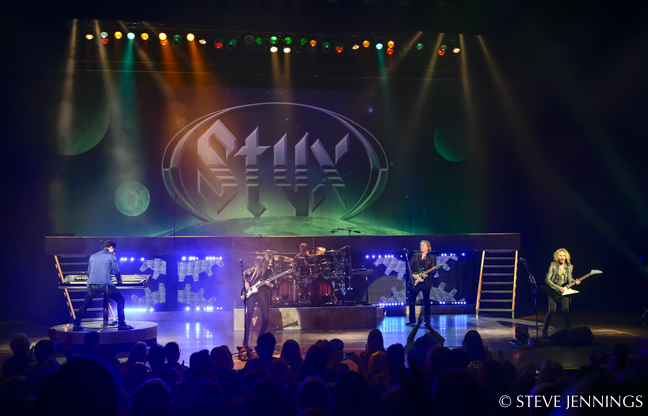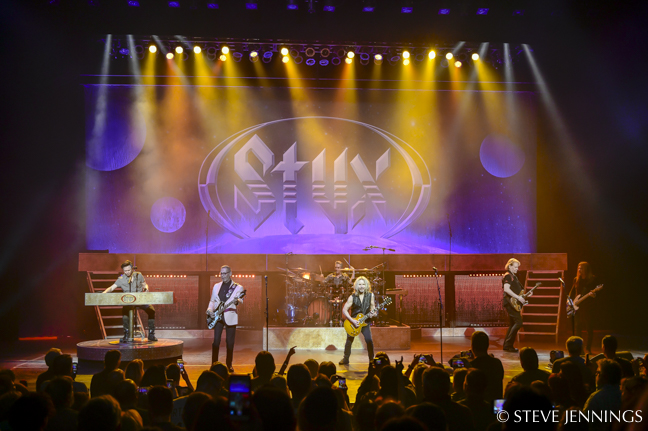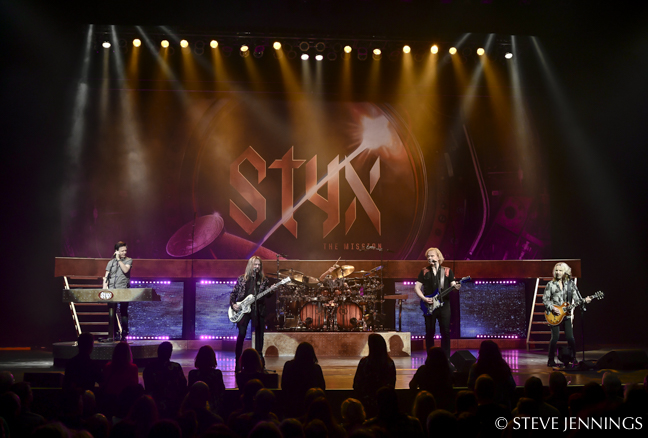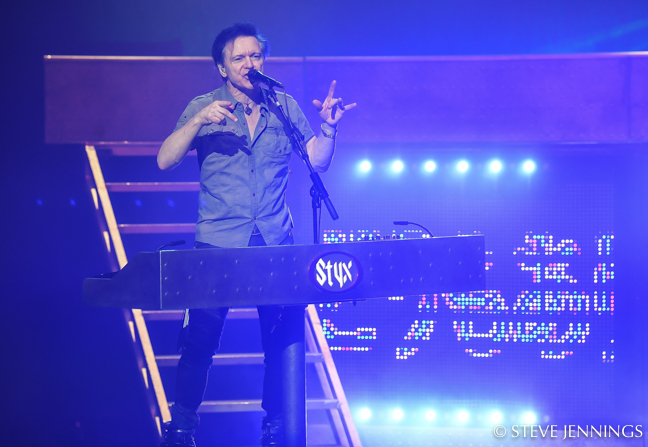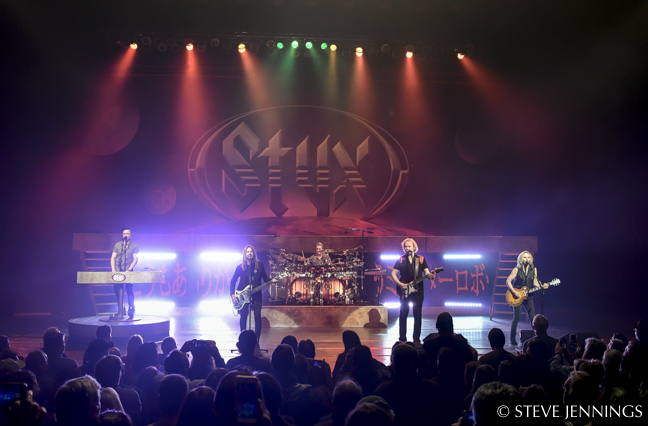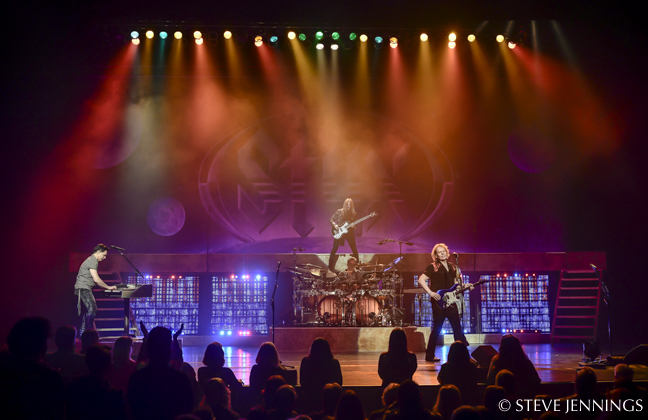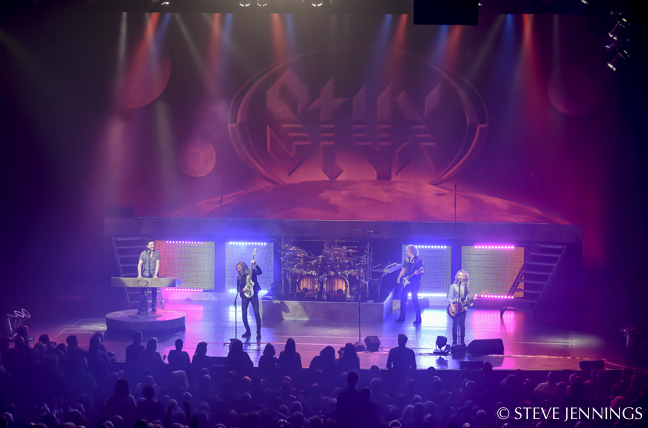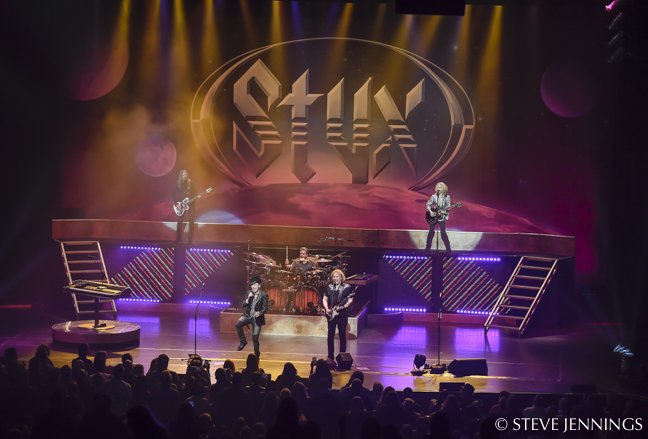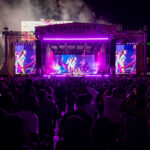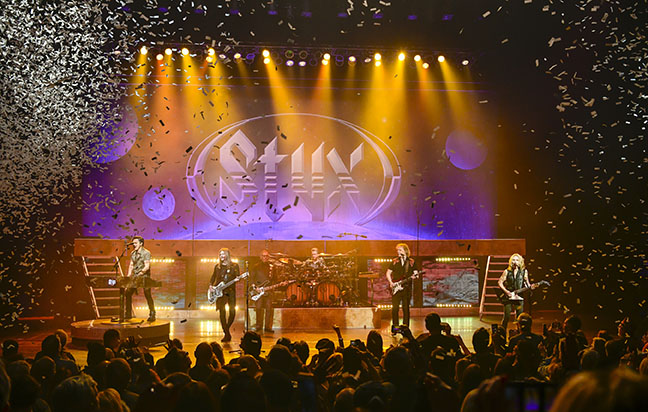
Lighting Co
- Impact Lighting
Venue
- Various (Tour)
Crew
- Lighting Designer: Jeff Ravitz
- Lighting Programmer, Associate Designer & Director: Libby Gray
- Video Content Creation & Playback Op: Libby Gray
- Production Managers: Brian Wong & Jeff Heintz
- Tour Manager: George Packer
- Assistant Tour Manager: Jason Powell
- Video, Backdrops: Styx-owned
- Staging: Styx owned, (built by Gallagher Staging) designed by Brian Wong
- Backdrops: Styx owned, (by Grosh)
- Trucking: Upstaging
Gear
- 1 grandMA2 Light console
- 120 Assorted Par 64 lamps (NFL, VNFL, MFL)
- 8 Chauvet Colordash Quad 12’s (Styx owned, built into set)
- 10 ETC Source Four Lekos
- 2 Audience lights (9-lite moles/8-lites)
- 8 Chauvet Colorado Batten 72s (floor lights for drop)
- 4 500W DYI custom fixtures on drum riser
- 2 Circuits of DWE Par 36 lamps (6 total) under keys riser
- 4 ACL Bars
- 6 Followspots
- 2 DF-50 hazers
- 4 EuroLite 20 soft video curtains in set wall
- 1 Madrix software setup on dedicated FOH PC
Designer Insights by Steve Jennings
Libby Gray
Lighting Programmer, Associate Designer & Lighting Director
PLSN spoke with Styx Lighting programmer, associate designer & director Libby Gray about this veteran band that has, after almost 50 years, the luxury of touring almost any format and duration they choose. “Full production summers in 16,000 seat sheds with other bands? Sure. Weekend-warrior winter jaunts only in warmer locales like Florida and California, in nice PACs who will hang a plot for us? You betcha. A pleasantly fat corporate check sandwiched between some casinos for some very light work during the holidays? Hell yeah. We work every month, totaling between 90 and 120 shows a year, every year! For an unbroken twenty years. The simple math tells the story of how unique this situation is for an LD. Aside from the obvious variety of venues and rigs, the backstory is that there’s never downtime; I advance virtually every day at home, because every different environment requires different work to achieve the same thing, which is a visually coherent, consistent, logical, and recognizable Styx show. The guys don’t rewrite ‘Blue Collar Man’ every night, so if you’ve done the work with thoughtfulness to create a visual frame that supports and reinforces the song meaningfully, integrity requires you try to reproduce it with fidelity every night no matter what the tools at hand. Either you believe in the design or you don’t: you’re not paid to just throw light around.
“In concrete terms, that means different work is required for different scale shows. For example, in arena and shed tours carrying 2 or 3 trucks of lighting and crew, there are equal parts of what I’d call designer ‘maintenance work,’ (massaging rigging points to get the right angles, optimizing house followspots) and the ‘detail work’ so beloved by all LDs when we have the time, like tinkering with milliseconds of effect timing, or exploring arcane console features, and it’s all just lovely.
“None of this is the work that you are doing solo, in a casino, where Styx just shows up with the world in one truck. Those are shows where you plug your desk into a house rig of assorted spinning-Goddamnits and launch into a frenzy of cloning, nonsensical foci, unpleasantly constructed networks, Mystery Chinese Knockoffs, and missed lunches. Really busy days have you writing personality profiles from scratch and on the phone to ACT to discuss protocol configs and you’re lucky to make the spot meeting.
“The point is that different sized-shows don’t have the same complexities in different sizes: they have completely different complexities. Compounding those complexities is the fact that for Styx I maintain concurrent rental plots for both a conventional 120K rig (still typical spec in fairs and small theatres) and a moving rig, for venues where they neither force a house rep plot on me nor are we carrying lights. If there’s a format shows are performed in: stadium, ballroom, shed, or theatre, with rental lighting, house rep plot, carried production or a combination thereof (see: shows performed with orchestras), I have to be able to do it competently, if not always with unrelieved joy. We also have a small moving plot, provided locally when conventionals are not available as Par cans become more scarce. This all is part of the narrative of how flexible Styx has to be since we play so many different sized shows in different environments. To repeat, neither of these are the plots for the bigger, summer shed tours we do most years.
“Working for Styx requires I be, in turn, home office grunt, designer, draughtsman, negotiator, working lighting roadie, programmer, board op, IT specialist (the worst!), spot director, video designer, and also… I help with the truck pack. Lots of touring lighting LD’s do lots of these things, but few do all of them all the time. The fact that Styx requires an ever-widening set of skills keeps the job from ever getting stale, and I like to imagine keeps me frosty-sharp and flexible in the game. For contrast, a behemoth artist can come stomping Godzilla-like into town and get what they want, every time, every day, but if you can’t throw your weight around like that, you’d better be light on your feet.
“Spot calling is a real pleasure to me (I know, weird), although it’s a dying art for two reasons. Firstly, It’s being supplanted by fly-by-wire spot driving. Secondly, there’s always been a big hole in the training of new directors coming from the intersection of the fact that 85% of tours (that’s a total guess, but I bet it’s close) can afford one person board op-ing and calling, but our industry is still mostly run on the apprentice-journeyman-master system. So where are new directors to be get trained, without a degree? Tours with board Op / Director as separate positions only hire the experienced, so these factors are combining to produce an entire generation of ‘Directors’ who have learned to call ad hoc, and this is not a guess: I hear nightly across the country from the Ops that fewer and fewer touring directors know how to call a cue correctly.
“So, first I enjoy being a torch-carrier for correct calling by itself, becoming rarer in music, as a point of professional pride. Beyond that, there’s a ‘flow’ that occurs when you’re driving a desk and calling simultaneously, when your hands and mouth are doing different things in different tempos that’s — I imagine — similar to drumming and is just plain fun. The desk requires definite structure and cadence to execute cues in order and in time, but speaking naturally and clearly requires a completely different rhythm and improvisation, and putting those elements together makes the show race by, blocking out everything but immediacy of the music and light. It feels like surfing looks: you’re completely in the moment and the power is almost overwhelming and you’re trying to steer the rush and then the show is over in like, a second or two… Unless your Ops are painfully bad and then the show lasts about 23 years and you’re just sad and bedraggled at the end.
“While I need to start with the traditional platitudes about having been privileged to work closely with great designers and learned-so-much-from-them-blahblahblah… in this case, it’s really true. I learned to call spots from the late, great David Finley and have spent so much time working next to Jeff Ravitz (I honestly can’t recall if we first toured together on Mellencamp or Steely Dan, in 93 or 94) I’d have to be some kind of stupid not to have some of his extraordinary skill rub off on me. Aside from demonstrating lighting nuts-and-bolts-and-vision, Jeff modeled for me behavior that was invaluable. Styx has always been Jeff’s special, formative band, and it was the trust that Jeff placed in me, in front of the band, that initially allowed them to trust me. That’s the million-dollar-lesson you can’t buy: how to earn your artist’s trust, how to convey to your artist that you trust another and they should too, and how to carry the responsibility of that trust.
“This is the ongoing evolution in the relationship between a designer and their band, which if long-term is always a fuzzy and potentially hazardous mix of client, paid pal, and genuine friend. It’s rife with traps I’ve seen tripped disastrously or elegantly navigated; I’m trying for the latter. For example, everyone makes mistakes, but I’ve learned the only way to handle a genuine pooch-screw is to run headlong into it and own it before anyone else can even raise a finger to point in your direction. Example: a few years back on a bigger shed tour, I thought it might be cool if the video wall said a personalized goodnight to the audience during bows, something innocuous like, “Thanks for coming, Virginia Beach!” and spent the day trying to get the scroll to read smoothly but visually, it didn’t work. However, that night after a triumphant sold out shed show, I accidentally rolled the test cue I’d been playing with during the day and “STYX LIKES DONUTS!!!” rolled across the video upstage of the band, during bows, in huge letters. Believe me, you wanna keep your band’s trust, you better be the first one in the dressing room to explain that sh*t.
“It may seem a clinical line from Styx board Op (‘96) to programmer (2000) to Director (2003) to occasional design, to taking the reins from Jeff most of the time, but it’s been a collaborative effort with lots of people in the room, all driven and talented but also sincere and genuinely kind, including supportive management at all levels. Everyone in this organization is improbably nice and is focused on improving a 50 year musical legacy, and that produces an interesting bond. It’s Us against Them on this ship.
“It’s an outgrowth of that Styx trust that enabled our keyboardist/lead vocalist Lawrence Gowan to hire me as his designer for his independent tour work in Canada, which we’ve been doing for ten years and is now typically several weeks in spring and fall. He had several prestigious lighting designers whose work I deeply admire before me, so it was a little humbling when he chose me, and it took him awhile to convince me he’d hired me because he liked my work rather than because I was cheaper. But I believe him now, mostly. It’s either that or our shared common initials. Gowan’s shows are a fun departure from Styx, as his part-time band changes members and accordingly his stage layout is a little different every season. He travels with a very small package, so I’ve added some weight- and space- efficient set elements like screen mesh legs to uplight (old tricks really are the best tricks), and the use of house consoles of many flavors (whole lotta ETCs in Canada) works my programming-learning chops every time.
“The first piece of advice I’d share with upcoming designers comes from my own mentor years ago, Broadway designer F. Mitch Dana, speaking about our lighting industry: “Although it’s crowded at the bottom, there’s plenty of room at the top.” It’s a message of perseverance, and I’ve got a corollary of my own authorship to add: Don’t have a ‘Plan B’. ‘Plan B’ is just a plan for ‘Plan A’ to fail. Don’t even admit the possibility into your consciousness by having a fallback. Decide you will succeed at this or starve in a cardboard box and you will be amazed at what you accomplish. I’m sure that advice won’t endear me to many parents, but it has worked for me for 30 years.”
More Styx photos by Steve Jennings:
